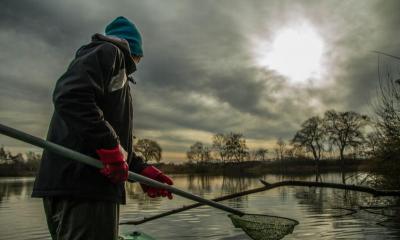
In the BAGGERSEE project, a shallow water zone is being created in a quarry pond managed by anglers as a valuable habitat for young fish, for example. Photo: BAGGERSEE
Anglers catch fish, kill them, and sometimes you can even find their garbage during a walk. Where the angling men and women appear with their rods at the water, they polarize. Moreover, anglers compete with bathers, boaters, walkers and other water users. The services that fishing clubs provide for the protection of species usually remain just as hidden from declared water enthusiasts as the fish that the anglers chase after. Researchers of the BAGGERSEE project at the IGB and the Humboldt-Universität zu Berlin have now investigated the question of whether and how recreational fisheries influences the species richness of water bodies. The project is funded by the Federal Ministry of Research and the Federal Ministry for the Environment, Nature Conservation and Nuclear Safety as well as the Federal Agency for Nature Conservation.
Anglers as troublemakers?
By means of special bank maintenance, which creates a mosaic of fishing spots and bank vegetation, anglers createbank habitats for invertebrates, birds and plants on lakes. The fishery managers also establish fish populations in artificially created quarry ponds which are very similar to those of natural lakes and even show a significantly increased species diversity compared to sand or gravel pits which are not managed by anglers. "Seven to eleven different species of fish swim in quarry ponds "occupied" by anglers, in comparison to only three to five in lakes not managed by anglers", states the fish biologist Sven Matern from IGB.
This is significant because about one third of our native freshwater fish species are highly endangered, as shown by another recent study: Other water-dependent animals such as dragonflies, water birds, but also water and shore plants are not significantly influenced in their species richness by anglers. "Their species diversity did not differ from the conditions that we found in unfished lakes in comparison," explains project leader Professor Robert Arlinghaus. The researchers were also able to detect a very special stonewort alga in a managed quarry pond: the multi-branched stonewort alga (Nitella hyalina), an aquatic plant threatened with extinction on a national level. The use of water ecosystems by anglers and the biotope value for nature conservation do not have to be mutually exclusive.
Anglers as Citizen Scientists
Researchers from IGB and the Humboldt Universität zu Berlin, in cooperation with fisheries biologists from the Angler Association of Lower Saxony and a number of active angling clubs, came to the results described here. Together they launched the BAGGERSEE project to find out how the aquatic biodiversity of artificial lakes can be increased with the help of angling water management. In a large number of lakes, the anglers brought in deadwood on their own initiative or created shallow water zones to help increase biodiversity. Anglers actively participate in research work and nature conservation measures in their free time and through paid membership fees. In workshops, they learn more about the findings of the BAGGERSEE researchers.
Anglers as illegal fish drop-outs?
But what about the fear of some water conservationists that alien or even invasive species such as grass carp are increasingly being released into the water by anglers? Such area-wide effects could not be confirmed by the large-scale study on a total of 27 quarry ponds in Lower Saxony. Non-native species were rare and then only occurred as single specimens. Regardless of the form of management, exotics were found in a few waters, which were presumably illegally released into the wild by pond owners or aquarium keepers.
Anglers as noisy garbage makers?
In fact, fishing clubs are increasing access to the waters by building paths and parking lots. As a consequence, these places are also used by other recreation seekers. According to the BAGGERSEE studies, this leads to more business and waste on the water. However, the unwanted legacies are also regularly removed by anglers during bank maintenance activities. On non-managed lakes, this has to be done by the public authorities or, if private, by the owner of the watercourse on his or her own initiative.
Anglers as users and species conservationists
According to current studies, angling waters have a high biological diversity. In particular, the Petrijungians promote the establishment of near-natural fish populations with more fish species. Even highly endangered aquatic plants can coexist with fish and anglers, despite carp and other bottom-dwelling species that anglers like to occupy. So the good news about Biodiversity Day is that nature conservation and nature use can go hand in hand.
The text was written by Eva-Maria Cyrus and Robert Arlinghaus and published by the Anglerverband Niedersachsen e.V. as a press release on the occasion of the International Day of Biological Diversity on 22 May 2020.
Publications:
Nikolaus, R., Schafft, M., Maday, A., Klefoth, T. Wolter, C., Arlinghaus, R. (2020). Status of aquatic and riparian biodiversity in artificial lake ecosystems with and without management for recreational fisheries: implications for conservation. Preprint doi: 10.1101/667493 (provisionally accepted with minor revisions in Aquatic Conservation: Marine and Freshwater Ecosystems).
Matern, S., Emmrich, M., Klefoth, T., Wolter, C.,Nikolaus,R., Wegener, N., Arlinghaus, R. (2019). Effect of recreational-fisheries management on fish biodiversity in gravel pit lakes, with contrasts to unmanaged lakes. Journal of Fish Biology, 94, 865–881.
Emmrich, M., Schälicke, S., Hühn, D., Lewin, C., Arlinghaus, R. (2014). No differences between littoral fish community structure of small natural and gravel pit lakes in the northern German lowlands. Limnologica, 46, 84–93. doi: 10.1016/j.limno.2013.12.005.






